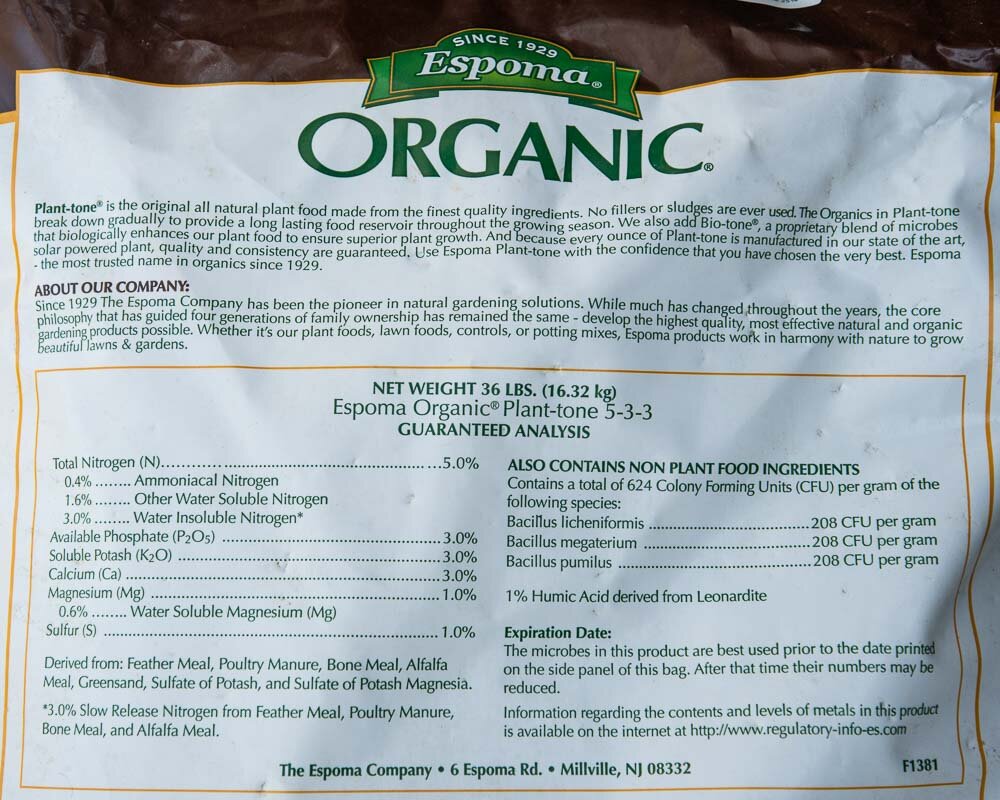by Mark Levisay
You’ve probably seen bags of 10-10-10 “plant food” at a big box store or garden center and may have wondered what those numbers mean. The numbers refer to the percentage by weight of N-P-K, or nitrogen, phosphorus, and potash (potassium) which are essential nutrients that plants need to grow. Rather than thinking of them as plant “food,” it’s helpful to view them as ingredients that the plant uses, along with sunlight, to manufacture food (sugars) that the plant needs to live. Let’s talk about those ingredients in a little more detail.
A little chemistry
Carbon, oxygen and hydrogen are readily available to the plant from the air and water (CO2 and H2O), but the nitrogen in the air is tightly bound up as N2 molecules and can’t be accessed by plants. Phosphorus (P) and potassium (K) are minerals that would usually be found in soil. These six elements are considered the major macronutrients plants need for growth. Calcium (Ca), magnesium (Mg) and sulfur (S) are minor macronutrients and might be lacking in some soils. Micronutrients are iron (Fe), zinc (Zn), molybdenum (Mb), manganese (Mn), boron (Bo), copper (Cu), cobalt (Co) and Chlorine (Cl). Most of these will be found in soil in adequate supplies for plants but can be added if a soil test indicates a deficiency.
The functions of N (Nitrogen), P (Phosphorus) and K (Potash)
The back of the fertilizer bag will provide details on the ingredients.
So, what do these individual nutrients of N-P-K do for the plants? Nitrogen promotes top and leaf growth and is essential to the plant. It’s transient in soil and will need to be added, at least yearly, depending on what plants you’re growing. Phosphorus is important for root growth and fruiting, but stays in the soil, so once added should be OK. This is also the nutrient that promotes algae blooms in Chesapeake Bay, so you’ll rarely see this nutrient in products like lawn fertilizer. Potassium promotes stem durability and cold hardiness and is also transient in soils, so we’ll have to keep up with this over time. A N/K ratio of about 1 is probably right for most average plants.
Soil testing provides your goal
To understand how you can improve your soil and provide your plants with the ingredients they need, you should test. You can guess at what’s in your soil by observing your plant’s growth, but testing will tell you for sure. Your county extension agent can help you learn more. The test results will tell you what’s in your soil currently and make recommendations to improve it for good plant growth. The recommendations will be expressed in pounds of nutrient per 100 or 1000 square feet. The test will also tell you the pH (measure of acidity), but we’ll talk about that in a separate blog.
The pounds of nutrients recommended is where the numbers on the bag come in. In our original example, 10-10-10 tells you there is 10% N-P-K in the bag by weight. A 40 pound bag has 4 pounds each of nitrogen, phosphorus and potassium, or 0.4 pounds per pound of fertilizer. The rest of the bag is an inert filler, which is important because too much nutrient too close to the roots of a plant will burn the roots. Some of the organic fertilizers are less potent, like Espoma’s Plant-Tone organic fertilizer at 5-3-3, so they can be added in larger quantity to the garden.
Watering is very important in relation to fertilizer application, and it’s uptake by the plants. The nutrients in our bag of fertilizer are in the form of nitrates, nitrites, phosphate and potash which break down into charged ions in water. These ions are then available to be absorbed by plant roots. 98% of the plant’s nutrient needs are absorbed in water taken in by the roots. Roots encountering dry particles of fertilizer can be damaged. Adding chemical fertilizers one to two weeks before planting seeds or plants can allow the fertilizer to become mixed in the soil and go into solution. I’ve had pretty good luck using Plant-Tone at planting time since it’s not too strong, but I always water well after planting.
With the right ingredients, your plants will trhive.
To learn more about the individual fertilizer requirements of specific plants, go to the Virginia Cooperative Extension website. You’ll also be able to find information about soil testing on the site.
Have a garden question? Send me an email at marklevisay@gmail.com.

